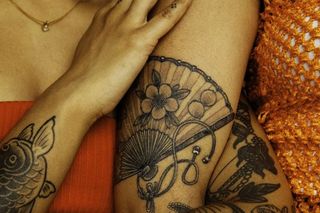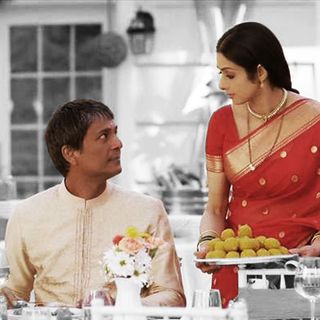
Tattoos Are a Political Act of Resistance in a Beauty Culture That Demands Conformity
“The tattoos stand for the control and say I have over my own body; [they are] a manner in which I reinforce and often regain ownership of it.”

28-year-old Tanvi Mishra has collected six tattoos in the last 13 years: a butterfly on her lower back, an oriental lotus on her left upper arm, a sketch-style skull just below the lotus, a peony on the back of her left hand, and two tiny tattoos of Joker and Harley Quinn on either wrist. There’s one more still, next to the lotus and the skull, but it’s a work-in-progress.
But, perhaps, Mishra’s recollection of her first tattoo is a more interesting point at which to begin. “I got my first secret tattoo when I was just 15 and in high school. A shy, emo school girl went on a solo trip to Australia and came back ‘badass’ because of a stupid tramp stamp of a cliché butterfly! But that will forever be a cherished experience. Nowadays, I’m 28 and happy with my ink and my blue-green hair,” she says.
‘Tramp stamp.’ Urban Dictionary has several unfortunate definitions of the misogynistic neologism, but here’s a rough coalescence: “A tattoo ‘strategically placed’ on a ‘dirty tramp’ or ‘sexually promiscuous woman’s’ lower back so that it can be seen ‘when you’re banging her doggy style,'” “to serve as bull’s eye [for depositing semen] after sex.” Also known as a “hoe stamp,” “bull’s eye” and “California license plate,” the ‘tramp stamp’ is the quintessential manifestation of oppressive ways in which womxn’s decisions to get inked are viewed. From whether or not they can get a tattoo, to what the design and the location of the tattoo say about the character of the women, tattoos are spaces where womxn’s agency over their own bodies directly clashes with patriarchy and its Frankenstein’s monster, a very demanding beauty culture that reduces women’s bodies to the binary of acceptable or unacceptable.
“I get stared at a lot. Everywhere. In every city in India,” says Mishra, the owner of a small textile mill in Jaipur. “Some people give me a look of disapproval, especially old people. Aunties will even make frowning faces at me. Just the other day, I was out at a pani puri stand and a woman — a young mother — came on a scooter with her two tiny daughters, looks at my tattoos and hair, and gave me the dirtiest look I have ever got!” Criticisms of Mishra’s tattoos include the consequential difficulties in getting a job or getting married, or running the risk of “looking like a hippie.”
But she’s good at rolling her eyes in such situations and others, from people touching her arms without her consent at parties to telling her tattoos cause cancer, to her mother telling her “enough tattoos, think about your marriage now! You’re old enough!” Because if tattoos are spaces of oppression, they are also spaces for feminism to resist the dichotomy of beauty standards and restraints imposed on the female body. Because dominant notions of femininity cannot be projected onto womxn’s tattooed bodies (tattoo culture has historically been male-dominated), it offers womxn the chance to use their bodies to embody and perform their own reflexive constructions of femininity.
“My tattoos have successfully spread the message that I am ‘badass’ and that I mean business. They have somehow been a symbol of strong character, for me.”
“As a woman, in this patriarchy pit of a country, I am not considered ‘enough.’ Strong enough. Boss enough. Intelligent enough. Capable enough. My tattoos intimidate people and make them rethink me as a person,” Mishra says, acknowledging her luck and privilege of having “a tribe” — friends and family — who offer little to no resistance to her getting tattoos. Her favorite one is the lotus, inked in memory of her grandmother, Kamala, who passed away when Mishra was abroad. “I was already living with the craving to get more ink [after the butterfly]. … I wanted to start a sleeve but I never had the perfect idea until that one day when I just got up and left for the tattoo studio all by myself and told the artist what [the lotus] will mean to me. … We started inking it the very next day. What a thrill!”
A sleeve — an arm filled with tattoos — directly and violently clashes with patriarchy’s rigid concepts of femininity which idolize fair, hairless, fragile arms. Mishra’s decision, then, to undertake the project of designing a left sleeve — and the unfinished seventh tattoo — symbolizes her way of resisting regulation in a world full of rules and norms (the blue-green hair helps). Her tattoos are her attempt at embodying multiple femininities — or even better, constructing her own version of feminity that is personal to her. In doing so, she reclaims her bodily agency while violating a major traditional gender role. “My tattoos have successfully spread the message that I am ‘badass’ and that I mean business. They have somehow been a symbol of strong character, for me,” Mishra says.
For womxn who consider their tattoos as an essential part of their identity and their feminism, it’s about commemorating acts of defiance: the act of getting a tattoo, the act of resisting and unlearning patriarchal truths deeply embedded in the conscious and subconscious, the implied act of self-determination in a society hell-bent on telling women who and how to be, and the struggle and strength necessary to commit these acts.
Related on The Swaddle:
For Women, a Shaved Head Isn’t About Getting Attention; It’s About Being Seen
33-year-old Tanvi Raj is a pansexual transwoman based in Mumbai, working in motion-design. After coming out as transgender and battling serious health issues, she decided to satisfy her childhood desire of getting a tattoo: an amalgam of a moth (to signify her evolution and the mental and physical battles she fought to identify as what she really is) and a warrior goddess (to signify the soul that helped her go through these battles and rise up stronger with every fall), with a circular arch on top (to signify her own soul’s armour). Raj says the tattoo makes her feel empowered; “that’s the sigil of my evolution, my story,” she says. “They are and will always be an important part of my identity. The lines, the shapes define the existence of my past battles, present ideology, and warpaint for the future.”
“It is a mixture of all the things I have gone through in my life and where I stand now. Resilience, being true to myself and not forgetting the pain I went through to get here,” explains 28-year-old Shreya. Based in Bangalore, with a career in advertising, Shreya thought about the design of her tattoo for three years, before finally getting it inked in Hanoi during a solo trip to Vietnam: a mixture of a lotus (for resilience) and an elephant (her favorite animal, a sign of being true to herself) on her inner right arm. Before that, she had to put out a few fires at home.
“My parents were quite against the idea of getting tattoos. My dad, in particular, told me that it causes stigma [against] unmarried girls and ‘reduces their chances’ to get married and that it was a decision to be taken only by her husband. He was extremely strict about it,” she says. It took some time, but things slowly changed and he became more open. When the solo trip was around the corner, Shreya made it a point to “tell him” and “not seek his permission”; her father, too, rose to the occasion. “It was quite assertive, and my dad was actually pretty cool about it,” she says.
“I feel like I belong to me,” she says, of how her tattoo makes her feel. “To me, it teaches me to be defiant as a woman. My defiance began at home with my father. I didn’t believe in any of that rubbish — that a woman needed permission from her husband to do things she liked to do. Getting this tattoo was an act of defiance to stay true to myself. I was privileged enough to not be chastised for it. It is a reminder of that, too.”
“The tattoos stand for the control and say I have over my own body, a manner in which I reinforce and often regain ownership of it and dispel the power that labels have for so long controlled me and dictated my life.”
The idea of tattoos as reminders, as little permanent sticky-notes of encouragement to carry with oneself through the day, take on added significance when the tussle between the politics of womxn’s tattoos and patriarchy intersects with mental health (and how that in itself intersects with the social oppression womxn face). How does society react to womxn who are simultaneously two taboo things: a person who dealt with/is dealing with mental health issues, and a womxn who has a tattoo?
Seven tattoos, in the case of 26-year-old graysexual ciswoman Sneha, of which the one on her bicep is the closest to her heart: three swallows, never flying too far away from the nest, serve as a reminder that regardless of distance, her family is always close to her heart. “I had it inked right after my depression took a very severe turn for the worse and led to an attempt on my life ending in self-harm scars that I wanted to have covered with a memory that would replace their existence,” she says, adding that she gets stared at quite often, but finds it hard to gauge if people are staring at “the tattoos or the scars surrounding them.”
While strangers can be excused for not knowing the story behind tattoos, it is at home, among those who know her intimately, that Dublin-based Sneha has to constantly negotiate and assert her ownership over her own body. “My family still continues to be very against tattoos. It leads to massive arguments, obvious disapproval and a refusal on their parts to acknowledge my tattoos,” she says. But she holds on to her desire to have them, and their importance to her: “They’re massively empowering for me. They bear witness to my survival.” Almost as if speaking for all womxn who get inked and embrace the politics of the act, Sneha adds, “The tattoos stand for the control and say I have over my own body, a manner in which I reinforce and often regain ownership of it and dispel the power that labels have for so long controlled me and dictated my life.”
The act of being a womxn exercising agency to modify one’s body away from social norms of beauty and propriety is inherently political — even for those womxn who don’t necessarily see their tattoos as having anything to do with their gender identity. The personal is political, and being apolitical is a political act, the sayings go. Even if tattoos are simply a way to express oneself, one’s interests, one’s visual fascinations, that is, even if the intention is not to prove a point, etch a reminder or underline a belief about womxn’s right to equality and bodily agency, just engaging in the act of getting tattooed is political because it requires stubbornly claiming the freedom to modify one’s body.
Related on The Swaddle:
What It Takes For the Urban Indian Woman to Dissent
When asked how her two tattoos — a geometric butterfly on her forearm, and dog paws on her waist — shape her identity as a womxn, 29-year-old Bangalore-based Aakriti Joanna, insists one has nothing to do with the other. And yet, her parents initially resisted her decision to get inked, fearing that she wouldn’t be taken seriously as a mental health therapist. “I went ahead and got them anyway,” she says, adding that she was the first in her family to get a tattoo and wants more of them. “[My parents] don’t seem to like that bit. For them, two are ‘more than enough.'” But Joanna is convinced: she loves her tattoos, they are a part of her skin, and she’ll definitely get more, unknowingly committing herself to the feminist act of resistance by (nonchalant) defiance.
“It makes me feel more like myself. I feel like I’m able to slowly customize my character with things like ink and hair color as and when I see fit, just like you’d build a videogame character.”
For 22-year-old Chennai-based Manasi Pathak and 27-year-old Bangalore-based Shalaka Pai, tattoos are about aesthetics and interests — a way to showcase their personality. Pathak, a sports journalist, has two tattoos — on her left arm, a huge clock showing the time of the Munich disaster, in which players and staff of football club Manchester United, along with few others, died in flight crash; and, on her right wrist, “cont;nue” (with the semicolon as a symbol for mental health and suicide awareness). “Through the tattoos, I am able to express myself better, and that they’re a good representation of my interests (my interest and passion for football) and beliefs (mental health awareness is necessary). … They give a good idea of who I am and what are some things I stand for/believe in,” she says.
For Pai, a freelance animator, editor, and illustrator who identifies as a queer cis-woman, it is the process of getting inked — from designing her tattoos to going alone to get them inked — that is addictive. She has eight tattoos now: “Six are on my arms, one is on my stomach and one is on my back. Three of them are floral, the one on my back is a geometric pattern. I have a quote on my stomach, a memorial tattoo for a lost kitten on my arm, a knife on my inner arm, and … a pair of glasses from the comic Transmetropolitan on my left wrist,” she explains.
Both Pathak and Pai faced resistance from their families initially — Pathak’s father did not approve; Pai’s parents “weren’t fond of the idea” and questioned her need to get tattoos. Nevertheless, they persisted and got tattoos anyway, until their parents came around. “It makes me feel more like myself. I feel like I’m able to slowly customize my character with things like ink and hair color as and when I see fit, just like you’d build a videogame character,” Pai says. “The ability to do that and the knowledge that you can, that’s pretty cool. It’s linked to the control you feel over your physical form.”
Call it what you will, but if that’s not a political statement of feminist resistance and rebellion in a beauty culture that demands conformity, then what is?
Related on The Swaddle:
Pallavi Prasad is The Swaddle's Features Editor. When she isn't fighting for gender justice and being righteous, you can find her dabbling in street and sports photography, reading philosophy, drowning in green tea, and procrastinating on doing the dishes.
Related


The First‑Ever All‑Woman Spacewalk Finally Happened After NASA Found Spacesuits That Fit
